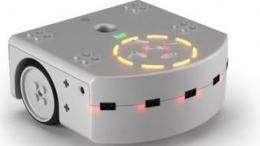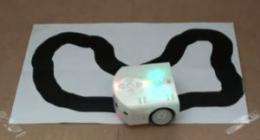EPFL robots will soon appear in school classrooms

(�鶹��ԺOrg.com) -- Swiss scientists have developed an educational robot designed to introduce children to technology in schools. Baptized Thymio II, it was officially presented to teachers in the Canton of Vaud last friday.
Creating an original pedagogical tool to get students interested in technology and robotics: this is the challenge that was undertaken by a group of the researchers led by Fancesco Mondada, in EPFL’s Robotics Systems Laboratory. In collaboration with the University of Art and Design Lausanne (ECAL), they developed Thymio II, a little programmable white robot, jam-packed with sensors and LEDs, that can exhibit a wide range of behaviours. “We worked really hard on the hardware,” Mondada explains. “Each sensor is associated with a coloured LED, which allows the kids to visualize the activation of the sensors during a specific manoeuver.” The Thymio II robots, which made their debut in May during EPFL’s robotics festival, has been presented to teachers on November 25, as part of a course organized by the cantonal teacher’s college (HEP).
Explorer, coward, investigator, friend
The 11 cm x 11 cm robot is equipped with proximity sensors (it can detect close objects), ground-directed sensors (it can detect the edge of a table around which it’s circulating, or a line to follow), accelerometers (It can measure acceleration, detect impacts and indicate gravity), a microphone and a temperature sensor (an electronic thermometer). It also has a memory card for recording sound. After they’ve turned their Thymio II on using buttons on the surface, users get the robot to adopt one of the basic modes, such as friend (follows an object in front of it), explorer (avoids obstacles), coward (detects impacts and empty space) or investigator (follows a line on the ground).
By hooking it up to a computer via a USB cable, users can invent and program other behaviours. “You could imagine the robot becoming blue when you put it in the fridge, for example,” suggests Mondada. The programming is done using a software called Aseba, which was developed by EPFL. “Aseba is a simple language, but it contains the principle concepts of programming,” Mondada continues. The software code is “open source,” available for modification or downloading over the Internet, and rights free.

From Lego to programming, by way of physics
Thymio II is not just a teaching tool for robotics professors. Thanks to its many sensors, it can also be used to teach physics, when subjects such as gravity, the properties of light and temperature are on the agenda. And thanks to its engaging character, the robot can also be used by children who are too young to understand programming. “It’s possible to stack Lego bricks on top of the Thymio II. Kids can decorate it and play with it to start with, then discover new kinds of behaviour over the Internet, and start to program it when they’ve gotten a bit older.”
Will Thymio II be a hit in the schools? Philippe Krähenbuhl , a science and robotics teacher at the Collège du Vevey, is enthusiastic. “Thymio II is inexpensive (about 99 francs), accessible, and very complete. It leaves room for creativity,” he says. “I appreciate the fact that you can use it in different ways, whether for building with legos, for teaching physics or for teaching programming skills.” For his part, Mondada says he welcomes suggestions from teachers, in order to improve the small white robot even further.
More information: More information:
Provided by Ecole Polytechnique Federale de Lausanne




















